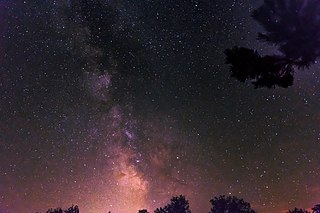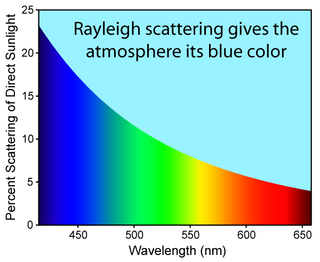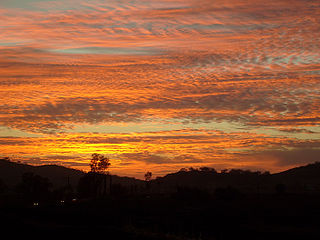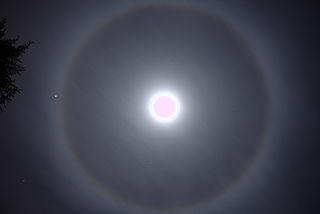
An afterglow in meteorology consists of several atmospheric optical phenomena, with a general definition as a broad arch of whitish or pinkish sunlight in the twilight sky, consisting of the bright segment and the purple light. Purple light mainly occurs when the Sun is 2–6° below the horizon, from civil to nautical twilight, while the bright segment lasts until the end of the nautical twilight. Afterglow is often in cases of volcanic eruptions discussed, while its purple light is discussed as a different particular volcanic purple light. Specifically in volcanic occurrences it is light scattered by fine particulates, like dust, suspended in the atmosphere. In the case of alpenglow, which is similar to the Belt of Venus, afterglow is used in general for the golden-red glowing light from the sunset and sunrise reflected in the sky, and in particularly for its last stage, when the purple light is reflected. The opposite of an afterglow is a foreglow, which occurs before sunrise.

Rayleigh scattering, named after the 19th-century British physicist Lord Rayleigh, is the predominantly elastic scattering of light, or other electromagnetic radiation, by particles with a size much smaller than the wavelength of the radiation. For light frequencies well below the resonance frequency of the scattering medium, the amount of scattering is inversely proportional to the fourth power of the wavelength, e.g., a blue color is scattered much more than a red color as light propagates through air.

Sunrise is the moment when the upper rim of the Sun appears on the horizon in the morning. The term can also refer to the entire process of the solar disk crossing the horizon.

Sunset is the disappearance of the Sun below the horizon of the Earth due to its rotation. As viewed from everywhere on Earth, it is a phenomenon that happens approximately once every 24 hours, except in areas close to the poles. The equinox Sun sets due west at the moment of both the spring and autumn equinoxes. As viewed from the Northern Hemisphere, the Sun sets to the northwest in the spring and summer, and to the southwest in the autumn and winter; these seasons are reversed for the Southern Hemisphere.

The sky is an unobstructed view upward from the surface of the Earth. It includes the atmosphere and outer space. It may also be considered a place between the ground and outer space, thus distinct from outer space.

Diffuse sky radiation is solar radiation reaching the Earth's surface after having been scattered from the direct solar beam by molecules or particulates in the atmosphere. It is also called sky radiation, the determinative process for changing the colors of the sky. Approximately 23% of direct incident radiation of total sunlight is removed from the direct solar beam by scattering into the atmosphere; of this amount about two-thirds ultimately reaches the earth as photon diffused skylight radiation.

Anticrepuscular rays, or antisolar rays, are meteorological optical phenomena similar to crepuscular rays, but appear opposite the Sun in the sky. Anticrepuscular rays are essentially parallel, but appear to converge toward the antisolar point, the vanishing point, due to a visual illusion from linear perspective.

In astronomy, an extraterrestrial sky is a view of outer space from the surface of an astronomical body other than Earth.

The night sky is the nighttime appearance of celestial objects like stars, planets, and the Moon, which are visible in a clear sky between sunset and sunrise, when the Sun is below the horizon.

Heiligenschein is an optical phenomenon in which a bright spot appears around the shadow of the viewer's head in the presence of dew. In photogrammetry and remote sensing, it is more commonly known as the hotspot. It is also occasionally known as Cellini's halo after the Italian artist and writer Benvenuto Cellini (1500–1571), who described the phenomenon in his memoirs in 1562.

A light beam or beam of light is a directional projection of light energy radiating from a light source. Sunlight forms a light beam when filtered through media such as clouds, foliage, or windows. To artificially produce a light beam, a lamp and a parabolic reflector is used in many lighting devices such as spotlights, car headlights, PAR Cans, and LED housings. Light from certain types of laser has the smallest possible beam divergence.

The Belt of Venus is an atmospheric phenomenon visible shortly before sunrise or after sunset, during civil twilight. It is a pinkish glow that surrounds the observer, extending roughly 10–20° above the horizon. It appears opposite to the afterglow, which it also reflects.

Volumetric lighting, also known as "God rays", is a technique used in 3D computer graphics to add lighting effects to a rendered scene. It allows the viewer to see beams of light shining across the environment. Examples of volumetric lighting are seeing sunbeams shining through a window and seeing sunbeams radiating when the Sun is below the horizon, also known as crepuscular rays. The term seems to have been introduced from cinematography and is now widely applied to 3D modeling and rendering, especially in the development of 3D video games.

The color sunset is a pale tint of orange. It is a representation of the average color of clouds when the sunlight from a sunset is reflected from them.

Atmospheric optics is "the study of the optical characteristics of the atmosphere or products of atmospheric processes .... [including] temporal and spatial resolutions beyond those discernible with the naked eye". Meteorological optics is "that part of atmospheric optics concerned with the study of patterns observable with the naked eye". Nevertheless, the two terms are sometimes used interchangeably.

Earth's shadow is the shadow that Earth itself casts through its atmosphere and into outer space, toward the antisolar point. During the twilight period, the shadow's visible fringe – sometimes called the dark segment or twilight wedge – appears as a dark and diffuse band just above the horizon, most distinct when the sky is clear.
In atmospheric optics, a photometeor is a bright object or other optical phenomenon appearing in the Earth's atmosphere when sunlight or moonlight creates a reflection, refraction, diffraction or interference under particular circumstances. The most common examples include halos, rainbows, fogbows, cloud iridescences, glories, Bishop's rings, coronas, crepuscular rays, sun dogs, light pillars, mirages, scintillations, and green flashes.

Optical phenomena are any observable events that result from the interaction of light and matter.

Crepuscular rays are sunbeams that originate when the Sun appears to be just above or below a layer of clouds, during the twilight period. Crepuscular rays are noticeable when the contrast between light and dark is most obvious. Crepuscular comes from the Latin word crepusculum, meaning "twilight". Crepuscular rays usually appear orange because the path through the atmosphere at sunrise and sunset passes through up to 40 times as much air as rays from a high Sun at midday. Particles in the air scatter short-wavelength light through Rayleigh scattering much more strongly than longer-wavelength yellow and red light.

Long-distance observation is any visual observation, for sightseeing or photography, that targets all the objects, visible from the extremal distance with the possibility to see them closely. The long-distance observations can't cover:






















